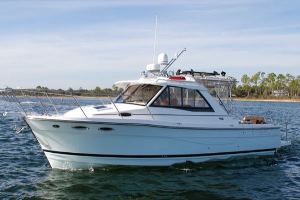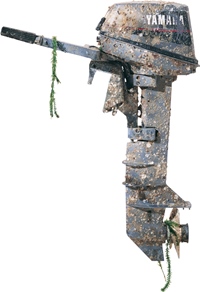
Robert Ullberg, Bertram Yacht
Robert Ullberg clearly remembers when he decided to become a sportfishing boat designer. During a billfish tournament in the mid-1980s with his father near Port Isabel off the Texas coast, he saw a Tom Fexas-designed Southern Cross sportfishing boat outrun all the other boats at the start.
“At that moment I knew I was going to work for Tom Fexas and design boats,” said Ullberg, 46, during an interview I conducted with him for Southern Boating magazine aboard a Bertram 80 at the Miami Yacht and Brokerage Show in February. Ullberg joined Bertram last summer as the builder’s vice president of Engineering and Product Development. “The tourney was a Bimini start and the Fexas-design boat just walked away from us.”
After the tourney, Ullberg climbed aboard the boat and learned about the fully-cored bottom design that the Australian-based builder Southern Cross used instead of the solid bottoms most builders were using during the 1980s.
“I knew right away I had to go the Miami Boat Show, find Tom Fexas and tell him I wanted to work for him,” Ullberg said. “That’s what I did. I went to the show, met him and sent him drawings.”
After earning a mechanical engineering degree at the University of Maine in 1991, Ullberg joined Tom Fexas Yacht Design in Stuart, Florida, and worked there for six years before founding Ullberg Yacht Design. After 16 years of running his own company, he joined Bertram last year. Here’s an excerpt from the entire interview:
SB: You began your career at Tom Fexas Yacht Design. How did working with this storied designer help you?
RU: On my first day of work, I came to the office all dressed up with a tie on. Tom Fexas came out with scissors and cut my tie off. I didn’t know whether to be upset or embarrassed, and Fexas said, “That gentleman over there will explain to you why we don’t wear ties here.”
I learned that when you lean over a drafting table your tie can slip and go over the ink that’s on the Mylars we drew on back then. If that happens, you’ve got a problem and it’s not a ruined tie. You have ruined your drawing. That’s why you will see pictures of designer Ray Hunt wearing a tie, but it’s a bow tie.
I learned so much from Fexas, but one important thing was before you go forward on a project, look back. Someone else has probably already done it, perfected it and thrown it away. You can learn a lot from following this broken road to perfection.
Another important lesson was to always have fun. If you are having fun then the rest of your job comes easy.
When I left Fexas I had his full blessing, and we remained close until he passed [away] almost five years ago. I bought all the assets of Tom Fexas Yacht Design afterward and I take huge pleasure in having all the drawings and file boxes. If you come to my library it’s all laid out. I am the curator. I donated all the Midnight Lace models to the Stuart Maritime Museum, but I have everything else.
Read the entire interview.








